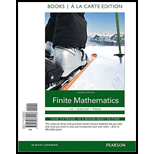
Concept explainers
Hole in One In the 1989 U.S. Open, four golfers each made a hole in one oil the same par-3 hole on the same day. Sports Illustrated writer R. Reilly stated the probability of a hole in one for a given golf pro on a given par-3 hole to be 1/3709. Source: Sports Illustrated.
(a) For a specific par-3 hole, use the binomial distribution to find the probability that 4 or more of the 156 golf pros in die tournament field shoot a hole in one. Source: School Science and Mathematics.
(b) For a sped lie par-3 hole, use the normal approximation to the binomial distribution to find the probability that 4 or more of the 156 golf pros in the tournament field shoot a hole in one. Why must we be very cautious when using this approximation for this application?
(c) If the probability of a hole in one remains constant and is 1/3709 for any par-3 hole, find die probability that in 20,000 attempts by golf pros, there will be 4 or more hole in ones. Discuss whether this assumption is reasonable.
Want to see the full answer?
Check out a sample textbook solution
Chapter 9 Solutions
Finite Mathematics, Books a la Carte Plus MyLab Math Access Card Package (11th Edition)
- Do the Laplace Transformation and give the answer in Partial Fractions. Also do the Inverted Laplace Transformation and explain step-by-step.arrow_forward18.9. Let denote the boundary of the rectangle whose vertices are -2-2i, 2-21,2+i and -2+i in the positive direction. Evaluate each of the following integrals: L₁ = 2- (a). dz, (b). (d). ₁ = 22+2 [ dz, (e). √, z COS 2 dz dz, (c). L (2z+1)2dz, z(z+1)' (1). [e² si 1 sin z+ dz. (22+3)2arrow_forwardQ1: For, 0 <|z| < 1, evaluate the following integral where g is ana 9(5) inside and on the unit circle C: a) Sc - α) δε 915 αξί b) Sc d. -1/2 Llc functionarrow_forward
- 纟 W₂ Find S-FX SB.MXarrow_forwardQ4: Find the value of fydz, where y is given in the figure. A B 2arrow_forward4. The revenue (in thousands of dollars) from producing x units of an item is R(x)=8x-0.015 x². a) Find the average rate of change of revenue when the production is increased from 1000 to 1001 units.arrow_forward
- MATH 122 WORKSHEET 3 February 5, 2025 . Solve the following problems on a separate sheet. Justify your answers to earn full credit. 1. Let f(x) = x² - 2x + 1. (a) Find the slope of the graph of y = f (x) at the point P = (0,1) by directly evaluating the limit: f'(0) = lim ( f(Ax) - f(0) Ax Ax→0 (b) Find the equation of the tangent line 1 to the graph of ƒ at P. What are the x and y intercepts of 1 ? (c) Find the equation of the line, n, through P that is perpendicular to the tangent line l. (Line n is called the normal line to the graph of f at P.) (d) Sketch a careful graph that displays: the graph of y = f (x), its vertex point, its tangent and normal lines at point P, and the x and y intercepts of these lines. Bonus: Find the coordinates of the second point, Q, (QP), at which the normal line n intersects the graph of f. 2. A rock is thrown vertically upward with an initial velocity of 20 m/s from the edge of a bridge that is 25 meters above a river bed. Based on Newton's Laws of…arrow_forward1 If ye y = sin x, find dy/dx and dy/dx² at (0, 0).arrow_forward3. Use the graph for problem #35, p175 to answer the questions. The average price (in cents) per gallon of unleaded gasoline in the United States for the years 2010 to 2019 is shown in this chart. Find the average rate of change per year in the average price per gallon for each time period. Source: U.S. Energy Information Administration. a) 2010 to 2013 b) 2012 to 2018 c) 2014 to 2019arrow_forward
- 4. Researchers at Iowa State University and the University of Arkansas have developed a piecewise function that can be used to estimate the body weight (in grams) of a male broiler during the first 56 days of life according to W(t)=48+3.64t+0.6363²+0.00963 t³ if 1St≤28, -1004+65.8t if 28arrow_forward3. Given the function h(x)=(x²+x-12 if x≤1 3-x if x>1' a) Graph the function h(x). Make the graph big enough to be easily read using the space below. Be sure to label all important aspects of the graph. b) Find all values of x where the function is discontinuous. c) Find the limit from the left and from the right at any values of x found in part b.arrow_forward2. Find the instantaneous rate of change for each function f(x)=2x²-x+3 at x=0..arrow_forwardarrow_back_iosSEE MORE QUESTIONSarrow_forward_ios
 Holt Mcdougal Larson Pre-algebra: Student Edition...AlgebraISBN:9780547587776Author:HOLT MCDOUGALPublisher:HOLT MCDOUGAL
Holt Mcdougal Larson Pre-algebra: Student Edition...AlgebraISBN:9780547587776Author:HOLT MCDOUGALPublisher:HOLT MCDOUGAL
 College Algebra (MindTap Course List)AlgebraISBN:9781305652231Author:R. David Gustafson, Jeff HughesPublisher:Cengage Learning
College Algebra (MindTap Course List)AlgebraISBN:9781305652231Author:R. David Gustafson, Jeff HughesPublisher:Cengage Learning Glencoe Algebra 1, Student Edition, 9780079039897...AlgebraISBN:9780079039897Author:CarterPublisher:McGraw HillAlgebra & Trigonometry with Analytic GeometryAlgebraISBN:9781133382119Author:SwokowskiPublisher:Cengage
Glencoe Algebra 1, Student Edition, 9780079039897...AlgebraISBN:9780079039897Author:CarterPublisher:McGraw HillAlgebra & Trigonometry with Analytic GeometryAlgebraISBN:9781133382119Author:SwokowskiPublisher:Cengage




